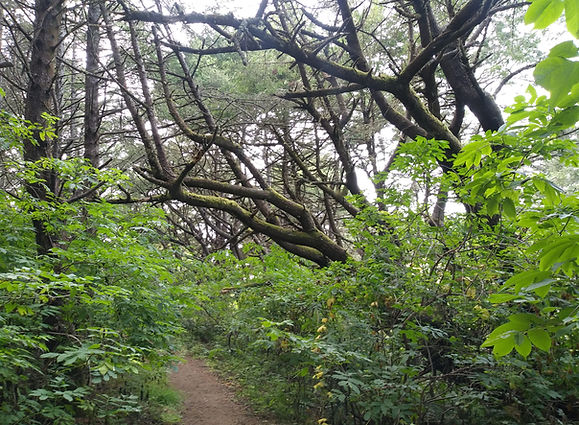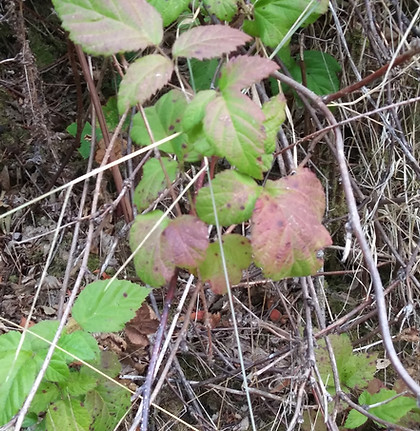

MAPs
More information and interesting facts about wild species residing
in the Shelter Cove Region
Shelter Cove offers three nature trails that can serve as excellent pathways to see and experience the diversity of habitats and animal species that reside in this northcoast region. The Shelter Cove Arts & Recreation Foundation (SCARF) led the development and funding for these wonderful trails, working with generous collaborators, supporters, and community volunteers.
The trails begin down at the ocean
shore environment and then go up
along a forested creek (the original
“Nature Trail”), through a steep
forested terrain that includes
crossing a seasonal creek (the
“Bill Franklin Nature Trail”), and
into a humid forest (the “Nature
Fitness Trail”). These trails include
several other features, such as
signs describing wild plant species,
unique benches if you need to rest,
and exercise stations if you would
like to have a balanced work out!
Further details on these trails are provided below:





ORIGINAL NATURE TRAIL
A 15 minute stroll appropriate for all ages and beginners too. The trail is located between Lower Pacific Drive and Upper Pacific Drive, and it is relatively level. If you begin at the Lower Pacific Drive entrance, follow the creek up about 50 feet to find signs on the left for the nature trail and for the 5th hole of the Shelter Cove Golf Links (see picture below). Continue along the northern edge of the air strip and into the woods. This trail is perfect for individuals looking for light exercise, fresh air, and beautiful scenery. Signs along the trail introduce you to a variety of local native plants and flowers (these signs were also developed through SCARF).





BILL FRANKLIN TRAIL – A 30-minute, more strenuous trail (some nickname it the “Cardio Trail”) appropriate for ages 6 and up. The trail is located between Upper Pacific Drive (across the road from the Original Nature Trail’s upper entrance) and uphill at the intersection of Seafoam Road and Hickory Road. The trail is about ½ mile in length, uphill all the way, and moderately steep in several places. There are benches along the climb that offer beautiful scenery and views, as well as spots to rest. The trail is used by some as an excellent workout for legs, heart and lungs. The trail offers a variety of opportunities to see different microhabitats and animals of different kinds moving around in sunny areas, shaded areas, and even a seasonal creek that you will cross over on way.
NATURE FITNESS TRAIL – A 15-30 minute trail, with a slight grade. Appropriate for all age groups. The trail is located between Shelter Cove Road and the north end of Upper Pacific Drive (up from intersection with Humboldt Loop). The trail features 10 exercise stations, each with instructions for different kinds of exercises (expect 30+ minutes when using the exercise stations). The trail runs along a canyon that is shaded by a thick forest canopy above, which makes the area humid and cool all times of year. Humboldt Creek runs all year, below the trail, and small feeder creeks are seen along the way, all contributing to the humid, cool environment, and beautiful scenery.









Safety & General Information
Going out into nature is one of the safest and healthiest activities around, but it is worth knowing what risks exist in order to plan and act accordingly. As you go out to enjoy the Shelter Cove Nature Trails and the many trails and sights through out the King Range National Conservation Area and Lost Coast, consider the following
1) Know your personal capabilities and engage appropriately: Hiking trails can become a rigorous activity depending upon your personal health and capabilities and the trails you choose to walk. Never take on more that you should and plan with moderation in mind. Two Shelter Cove Trails have only slight grades, the Original Nature Trail and the Nature Fitness Trail. Another important consideration is the weather. Even though our area is near the cool Pacific Ocean, you can easily find yourself in a hot and sunny (especially in summer) or very chilly (especially in winter) situation. Dress accordingly and bring water. Also, bring your cell phone, since many locations in our area may have tower service.
2) If you have small children, or pets, be watchful of them: Consider the points just made (under #1) with respect to the children and/or dogs you are bringing along. Also, consider the points made below (#3 and #4). All trails have potential hazards such as nearby steep slopes or poison oak, both of which can be minimized by staying on trail and ensuring your
children and pets do too. Please leash your dogs and use bags provided by SCARF to discard any animal waste.


3) Plants to avoid - poison oak and stinging nettles
These plants can leave you with a very uncomfortable rash! Thankfully, they are typically away from the trail in most places. They prefer to grow under cover and shade of other plants, like bushes and shrubs, so be careful when you are moving through this kind of vegetation. Know how to identify them. Poison Oak has three leaves on a common stem (see picture below). Note (!!) that Wild Blackberry, which lives in the very same areas, also has three leaves on a common stem (see picture below). To tell these two plants apart, Poison Oak has smooth leaf surfaces as well as smooth leaf edges, while Blackberry has more textured leaves with rough edges. You can also see what Stinging Nettle looks like, scroll down just below.
Poison Oak

Wild Blackberry

Stinging Nettle


Engaging in Nature and Using Trails In and Around Shelter Cove
TRAIL INFORMATION
4) Animals to avoid: Although the basic nature of animals is to be afraid of humans and to keep a safe distance or run away, sometimes both human and animal will surprise each other by being closer than is comfortable. Although highly unlikely, what if a large mammal or a rattlesnake is too close for comfort? In that moment, just remain still and let the animal escape, which is what it wants to do. You can even slowly back away from most animals, except cougars (=mountain lions) and rattlesnakes. If it is a cougar, hold your hands up in the air (like a referee during a touchdown in football) since it makes you look big (don't look small) and keep your eyes on it which will help to scare it away. If it is a rattlesnake that's within a few feet of you, don't move at all and wait for it to escape, which is what it wants to do (and so do you!). Also, just because an animal is smaller and maybe even cute (like a racoon or a weasel) it doesn't mean that it won't be aggressive if it feels threatened (or, if it's a skunk, it might squirt you with a very special perfume!).
Remember that animals do not want any troubles with humans. And please, never feed wild animals, as that teaches them to come back for more... and this often leads to future problems that can end up in death of the animal.
If you want to know more about some of these animals, use the links below:
Rattlesnake (by the way, this is the only dangerous snake in our area --all others are safe)
Black Bear __ Cougar (Mountain Lion) __ Bobcat __ Elk __ Coyote____Striped Skunk







